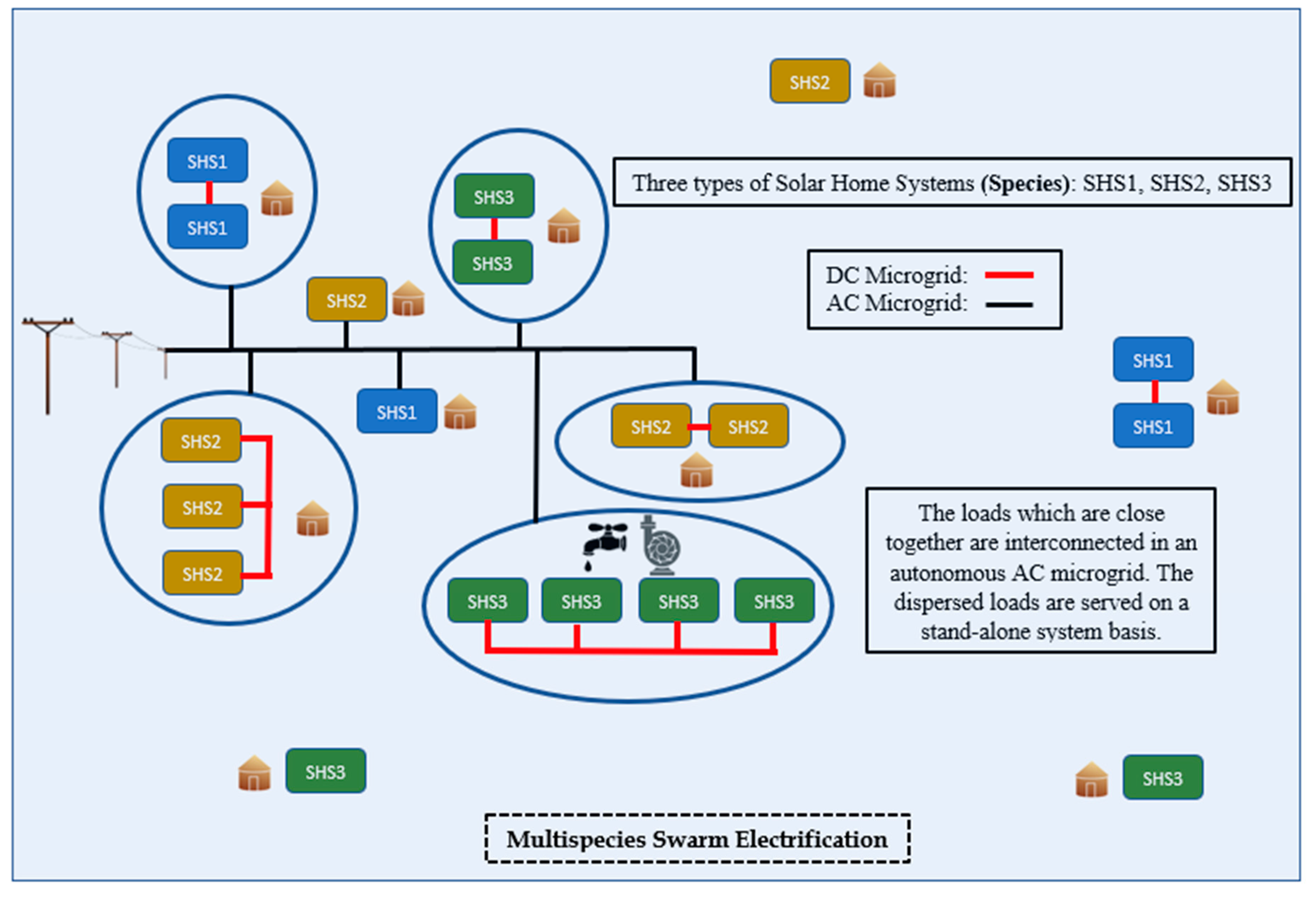Multispecies Swarm Electrification for Rural Areas of the Developing World
Abstract
:- An easily expandable and upgradable system to provide any tier access needed to any location using just 3 building blocks.
- A cost-effective approach since low-cost hardware can be utilized for the controllers/Energy Management System.
- It can operate in isolation (solar home system) or interconnected forming a microgrid.
- It can have an embedded smart metering solution to allow for a pay-as-you-go scheme, minimizing the cost for the investor.
- Through the extended metering infrastructure in the multispecies swarm, maintenance can be programmed in an easier manner and electricity theft monitored with accuracy.
- It simplifies and lowers the cost of designing, implementing, operating, and maintaining rural electrification projects.
- The above benefits do not increase the production cost of the base systems.
Conflicts of Interest
References
- IEA. World Energy Outlook 2018; IEA: Paris, France, 2018. [Google Scholar]
- IBRD/WorldBank. State of Electricity Access Report 2017; IBRD/WorldBank: Washington, DC, USA, 2017. [Google Scholar]
- Dagnachew, A.G.; Lucas, P.L.; Hof, A.F.; Gernaat, D.E.H.J.; de Boer, H.-S.; van Vuuren, D.P. The role of decentralized systems in providing universal electricity access in Sub-Saharan Africa—A model-based approach. Energy 2017, 139, 184–195. [Google Scholar] [CrossRef]
- GOGLA. Global Off-Grid Solar Market Report—Semi-Annual Sales and Impact Data; GOGLA: Utrecht, The Netherlands, 2018. [Google Scholar]
- GOGLA. Global Off-Grid Solar Market Report—Semi-Annual Sales and Impact Data; GOGLA: Utrecht, The Netherlands, 2017. [Google Scholar]
- Scott, A.; Diecker, J.; Harrison, K.; Miller, C.; Hogarth, R.S.W. Accelerating Access to Electricity in Africa with Off-Grid Solar—The Market for Solar Household Solutions; ODI: London, UK, 2016. [Google Scholar]
- Butare, A.; Kyriakarakos, G. Guidelines for Institutional and Policy Model for Micro-/Mini-Grids; EU Technical Assistance Facility for Sustainable Energy for the benefit of the African Union Commission: Addis Ababa, Ethiopia, 2018. [Google Scholar]
- Bhatia, M.; Angelou, N. Beyond Connections—Energy Access Redefined; World Bank Group: Washington, DC, USA, 2015. [Google Scholar]
- International Finance Corporation, World Bank Group. Benchmarking Mini-Grid DESCOs 2017 Update—Summary of Findings; IFC: Washington, DC, USA, 2018. [Google Scholar]
- Swarm Behaviour. Available online: https://en.wikipedia.org/wiki/Swarm_behaviour (accessed on 2 August 2019).
- Ben-Jacob, E.; Finkelshtein, A.; Ariel, G.; Ingham, C. Multispecies Swarms of Social Microorganisms as Moving Ecosystems. Trends Microbiol. 2016, 24, 257–269. [Google Scholar] [CrossRef] [PubMed]
- Kampwirth, R. SchwarmStrom—Die Energie Der Zukunft; LichtBlick: Hamburg, Germany, 2009. [Google Scholar]
- SchwarmEnergie®: Intelligente Energie Für Ein Neues Energiezeitalter. Available online: https://www.lichtblick.de/schwarmenergie/ (accessed on 2 August 2019).
- Fairley, P. “Swarm electrification” powers villages [Resources_Startups]. IEEE Spectr. 2018, 55, 21. [Google Scholar] [CrossRef]
- Groh, S.; Koepke, M. A System Complexity Approach to Swarm Electrification. In Proceedings of the International Symposium for Next Generation Infrastructure, Schloss Laxenburg, Vienna, Austria, 30 September–1 October 2015; pp. 283–290. [Google Scholar]
- Koepke, M.; Groh, S. Against the Odds: The Potential of Swarm Electrification for Small Island Development States. Energy Procedia 2016, 103, 363–368. [Google Scholar] [CrossRef]
- Kirchhoff, H.; Kebir, N.; Neumann, K.; Heller, P.W.; Strunz, K. Developing mutual success factors and their application to swarm electrification: Microgrids with 100% renewable energies in the Global South and Germany. J. Clean. Prod. 2016, 128, 190–200. [Google Scholar] [CrossRef]
- Medici, A. Electric Energy Supply Unit and Controller for Same. Patent number WO2017215752A1, 21 December 2017. [Google Scholar]
- Engler, A.; Meinhardt, M.; Rothert, M.; Wollny, M. New Generation of V/f-Statics Controlled Battery Inverter Sunny Island—The Key Component for AC Coupled Hybrid Systems and Mini Grids. In Proceedings of the 14th International Photovoltaic Science and Engineering Conference (PVSEC-14), Bangkok, Thailand, 26–30 January 2004. [Google Scholar]

© 2019 by the authors. Licensee MDPI, Basel, Switzerland. This article is an open access article distributed under the terms and conditions of the Creative Commons Attribution (CC BY) license (http://creativecommons.org/licenses/by/4.0/).
Share and Cite
Kyriakarakos, G.; Papadakis, G. Multispecies Swarm Electrification for Rural Areas of the Developing World. Appl. Sci. 2019, 9, 3992. https://doi.org/10.3390/app9193992
Kyriakarakos G, Papadakis G. Multispecies Swarm Electrification for Rural Areas of the Developing World. Applied Sciences. 2019; 9(19):3992. https://doi.org/10.3390/app9193992
Chicago/Turabian StyleKyriakarakos, George, and George Papadakis. 2019. "Multispecies Swarm Electrification for Rural Areas of the Developing World" Applied Sciences 9, no. 19: 3992. https://doi.org/10.3390/app9193992
APA StyleKyriakarakos, G., & Papadakis, G. (2019). Multispecies Swarm Electrification for Rural Areas of the Developing World. Applied Sciences, 9(19), 3992. https://doi.org/10.3390/app9193992





